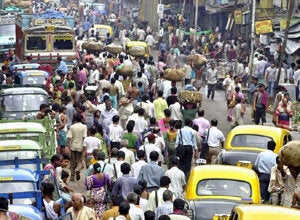
I had the surreal and not wholly unfamiliar experience yesterday of revisiting some of the grittier locales of Bombay* in Slumdog Millionaire and then going to the opening of a swanky Indian-Latin fusion restaurant called Vermillion in midtown Manhattan. One of the pretty owners greeted her guests in an elegant and sexy gold- and silver-sequined sari. As I joined the crowd enjoying pani puri margaritas (a touch heavy on the cumin) and puffed rice crackers -- usually a street-vendor staple -- off of rectangular porcelain, I thought of how often I had made this trip from high to low and back again, not simply in India but in Bombay in particular. It was the writer Suketu Mehta, whose Maximum City is the definitive nonfiction work about the megalopolis, who told me when I was doing daily research in the red-light areas for my novel, "This is no place to be a puritan. You can't be Mother Teresa here. You've got to embrace the paradox! Go eat some chocolate cake at the Taj." That paradox is why the city translates so well to the screen, especially through the lens of the high-octane fueled sensibility of Danny Boyle, careening among such varied realms as shantytown, call center, traffic jam, red-light area, abandoned five-star hotel, and the television soundstage. What I think Slumdog does so effectively, in addition to portraying poverty up close without veering into the maudlin trap, is deal with the media-driven, consumeristic vertigo that so many people in India experience (80% still live on less than a dollar a day). TV is a daily reminder to have-nots of what they have not, and yet television has also managed to loosen the grip of a once rigid caste-system on society: see the wild success of the talk-show host in Madras who just happens to be a transgender woman, or consider a woman who cleans public toilets, an untouchable, who is tuning into the same shows as the middle-class housewife or well-paid fashion model -- for once, they share an experience. While I admired Slumdog, I could never take it completely literally, but rather as a hybrid of suspenseful Bollywood-style melodrama and the touching naturalism of films like Mira Nair's Salaam Bombay or Walter Salles' Central Station, with a distinctly modern twist. Late in the evening at Vermillion, I met an Indian literary lion who knows Bombay better than most of us will ever know any city. He told me that he had problems with the movie: "Where did the brother get the gun? What was that Taj sequence about? Can you imagine an Indian director making a movie about New York and it being considered authoritative?" But he added, "Slumdog will get the Oscar." I told him I thought those narrative wobbles were in the spirit of the broad brush strokes of Bollywood (or Hollywood, for that matter). But what I didn't get a chance to say was that yes, I could imagine an Indian director making that film with success -- such is our shrinking world--and that any artist who bothers to look at extreme poverty (in all its shit-covered inexplicability) with an unflinching eye and manages to keep us from turning away, has something worthwhile to say.
*Bombay was renamed Mumbai by the violent Hindu fundamentalist political party, Shiv Sena, which was responsible for the 1992 massacre of 1400 Muslims, depicted at the beginning of the movie. These days, the city calls itself by both names, and I choose to use Bombay.
Originally posted at TribecaFilm.com.